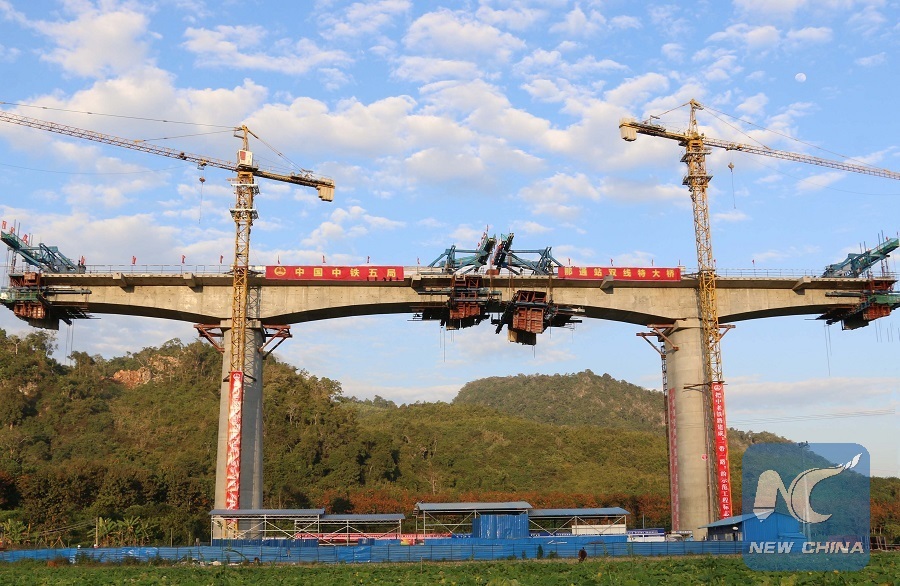
Constructors work at the site of the first cast-in-place continuous beam of the China-Laos railway at the under-construction Nathon Station Double-track Super Major Bridge, some 360 km north of Vientiane, capital of Laos, Jan. 18, 2019. (Xinhua/Huang Zongwen)
by Zhang Jianhua, Wang Shan
VANG VIENG, Laos, Feb. 26 (Xinhua) -- The China-Laos railway is gradually revealing its first signs of true glory, as the bridge and roadbed are taking shape and vehicles loaded with equipment are continuously entering and exiting the tunnel.
The construction of the China-Laos railway has offered more than 5,000 jobs to local people and changed the lives of local villagers whose dreams have now come true.
Bounma Chalernsak, 38, works as a driver for the railway project, and his wife, 33, works as a cleaner.
They have two children in middle school and elementary school respectively. Education requires a lot of financial support and prior to working on the project, they were barely making ends meet.
"Now, my income is higher than before, and is paid on time. In addition, my wife and I can work together," Bounma said.
He used to drive before working on the China-Laos railway project, and his wife planted rice, corn and potatoes in the westernmost province of Laos.
"I hope that someday I can send my children to study in China and contribute to the increasingly close cooperation and exchange between China and Laos," Bounma said, who holds great expectations for his children and hopes they will be proud of their parents' participation in the railway construction.
The China-Laos railway starts from northern Laos bordering China, and ends in Vientiane, the capital of Laos.
It is more than 400km long and its construction has adopted Chinese technical standards and used Chinese equipment.
The construction started in December 2016 and swung into full gear in mid-2017. It is scheduled to be completed and opened to traffic in December 2021, hence this year is a crucial one ahead of the successful completion of the railway.
Bounma and his Chinese colleagues have already made history in Laos. The Ban Somsanook No. 2 Tunnel, which was built by the PowerChina Sino-hydro Corporation Engineering Bureau 15 Co. Ltd., was successfully completed on Dec. 12, 2017.
It became the first tunnel bored along the China-Laos railway and the first modern traffic tunnel in Lao history.
"The villages along the railway have changed a lot and developed rapidly. Villagers often come to see the construction," Lien Vongphuk, deputy village chief of Phonthong Village near the railway tunnel told Xinhua.
"The villagers here used to make their living from farming and agriculture. Now, however, the railway project has increased the employment and income of the villagers in remote areas, and improved their living standards," he said.
More fruit trees will be planted and more livestock will be fed in the village after the completion of the railway. The project is really a win-win situation for everybody, he added.
Somechai Xayyavong, 34, joined the China-Laos railway project because of his dream of working in technology. He used to work for local firms building hydro-power plants.
When the railway project was launched, he was eager to be employed by PowerChina Sino-hydro Corporation Engineering Bureau 15 Co. Ltd.
"The salary is higher and the working environment is better than my previous job," Somechai said.
"But the point for me is the equipment used by Lao survey teams is not as advanced, so I have learned and gained more know-how about to use more advanced apparatuses and equipment since I started working here," Somechai said.
At the just-concluded China-Laos Railway Construction Working Conference 2019, Somechai Xayyavong was awarded the honorary title of "Railway Craftsman" of the China-Laos Railway in 2018.
"The railway construction in Laos has just begun. In the future, the railway will run through the whole country from north to south," Somechai said.
He said that he had always hoped to work with the Chinese to build railways and to accumulate enough experience and technology to open his own surveying and mapping company in the future so as to be able to further cooperate with the Chinese.

